All

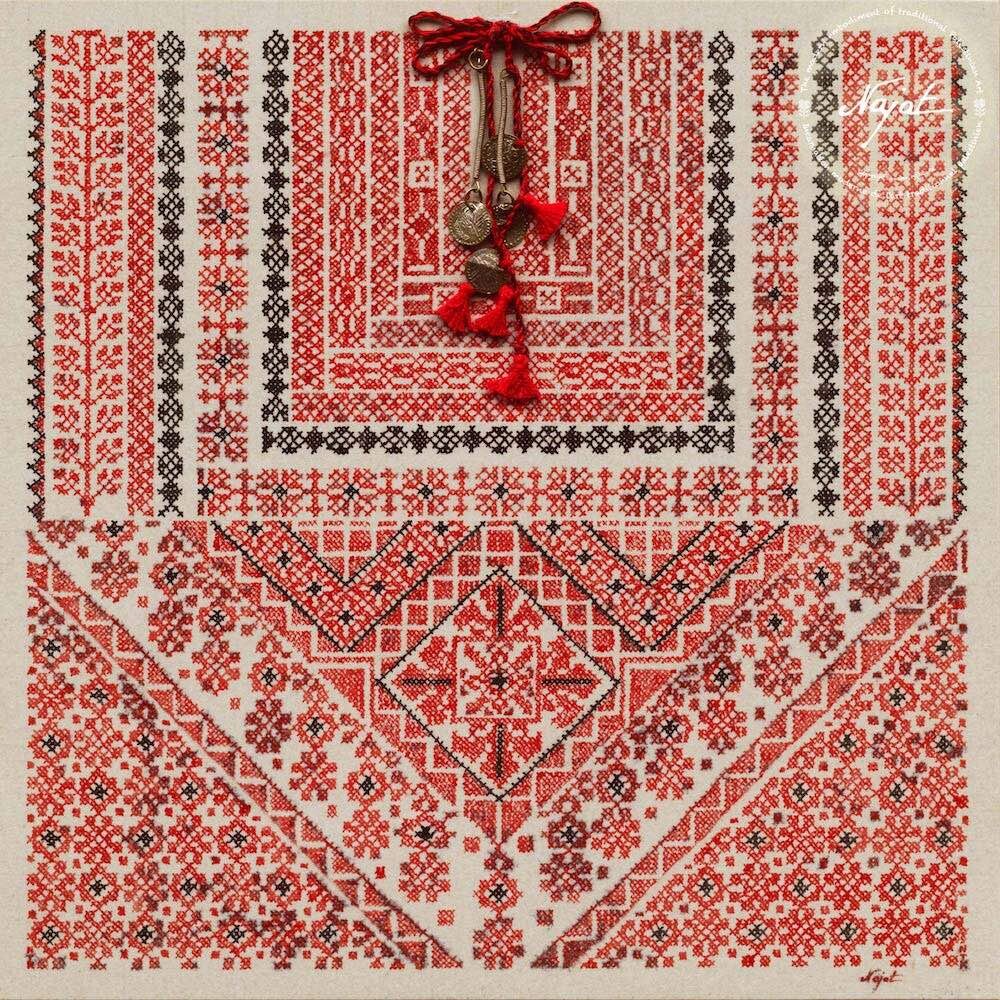





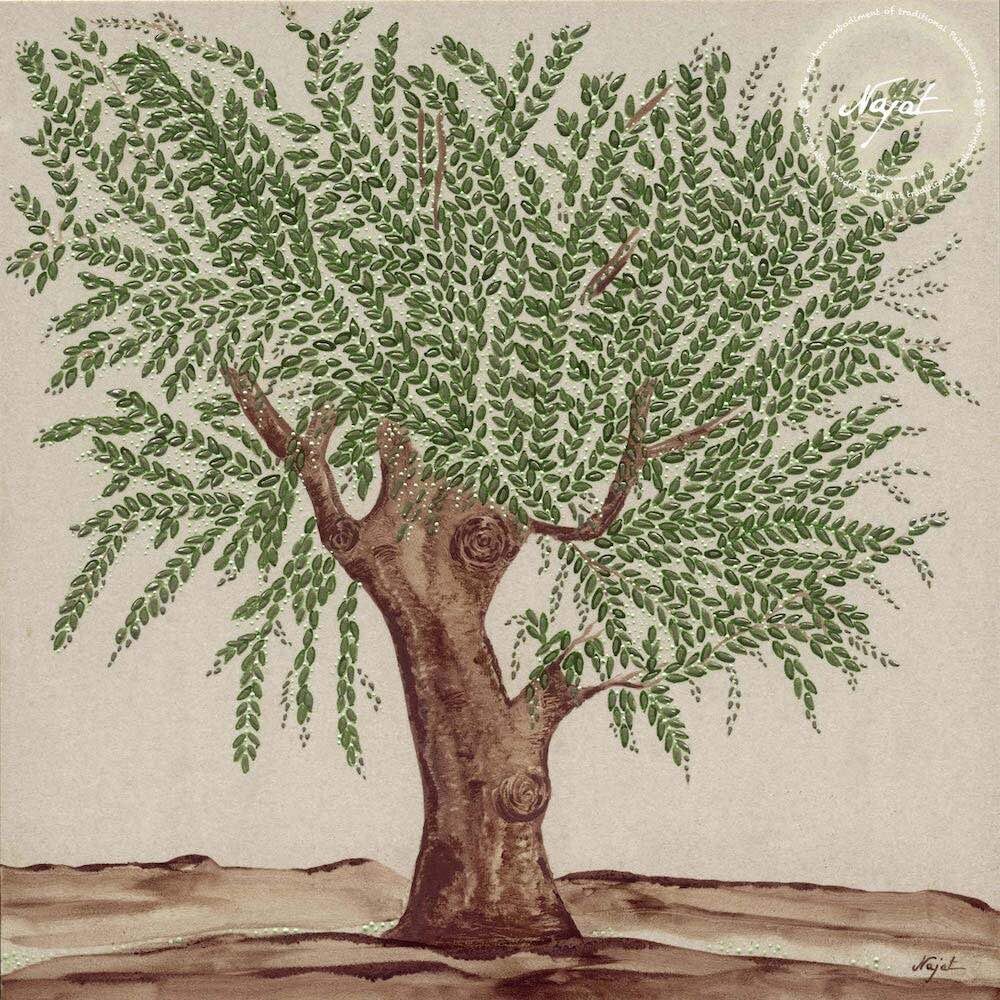



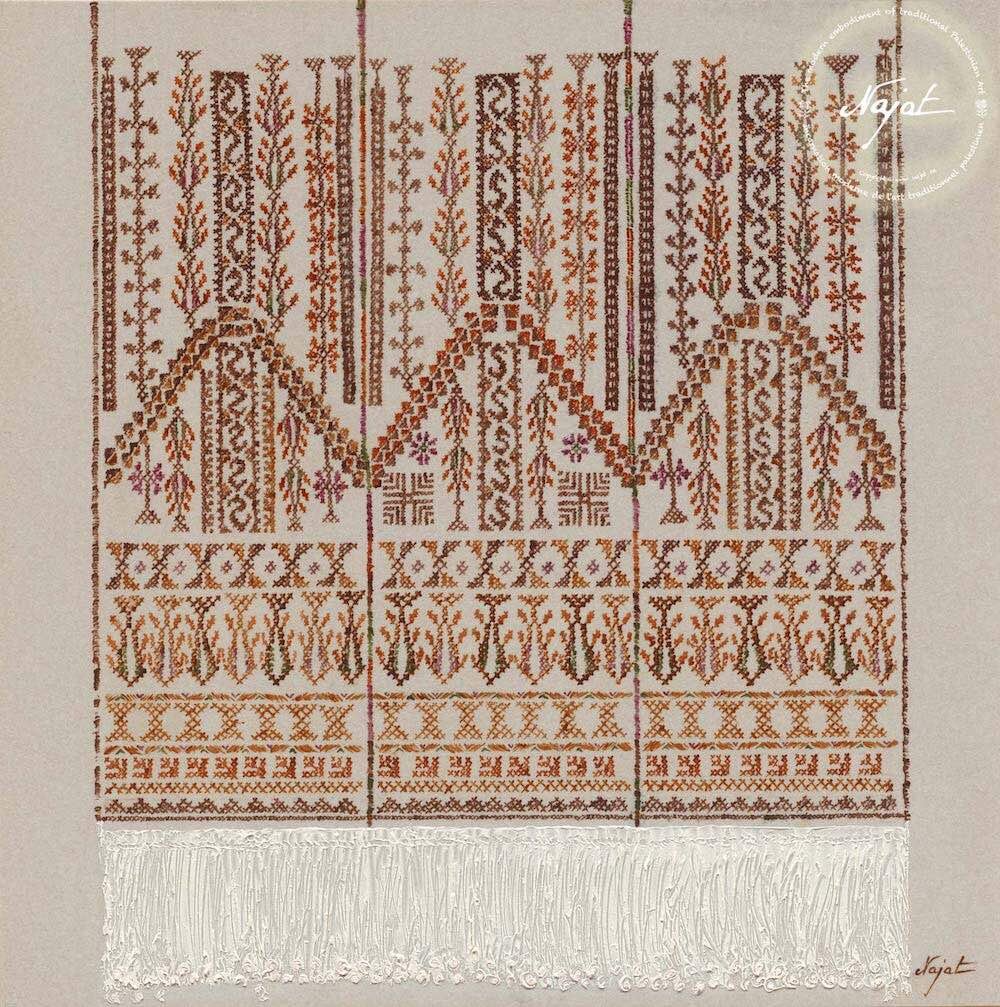
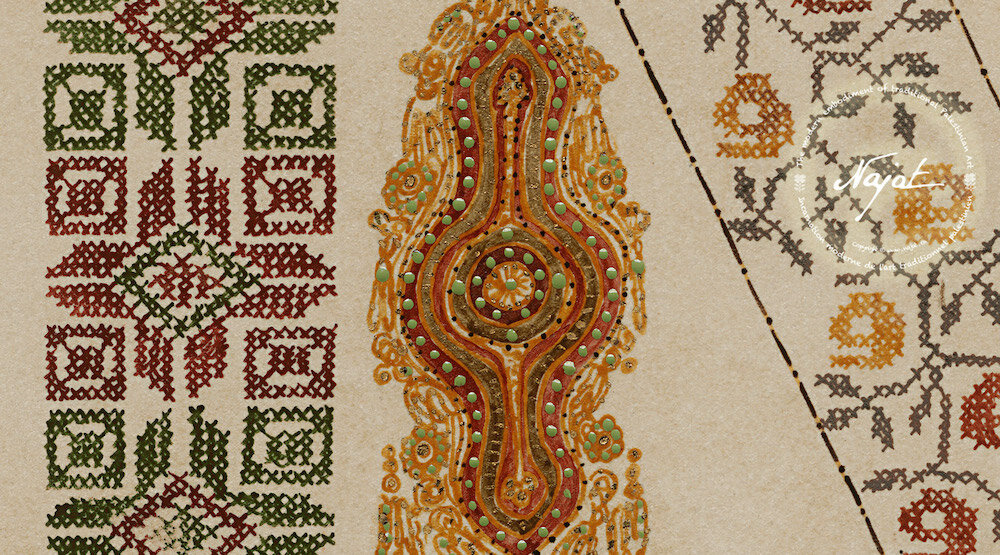





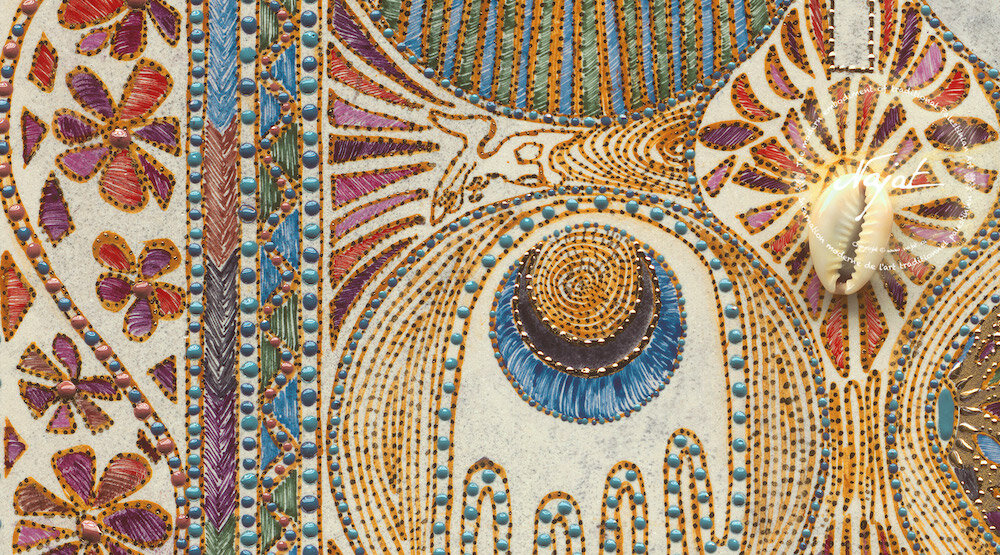
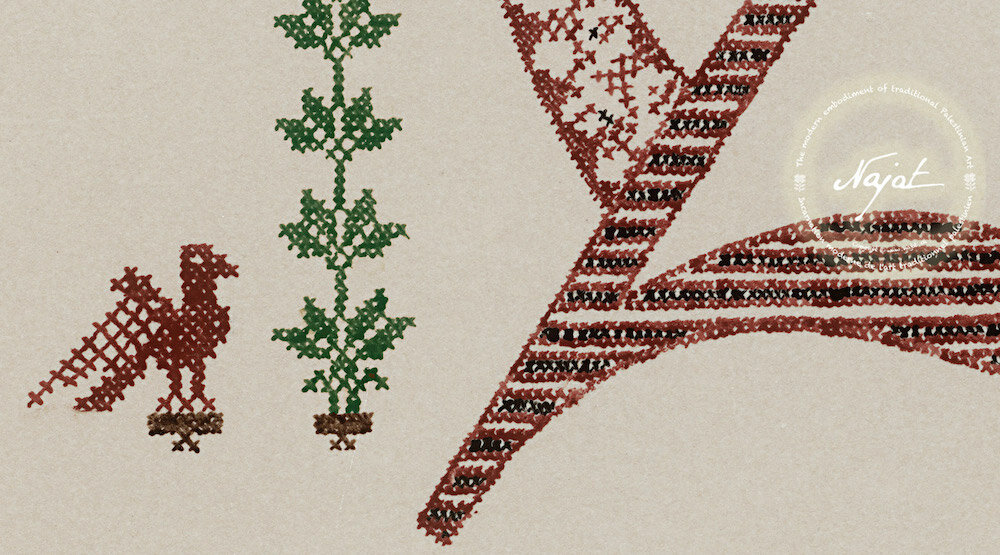


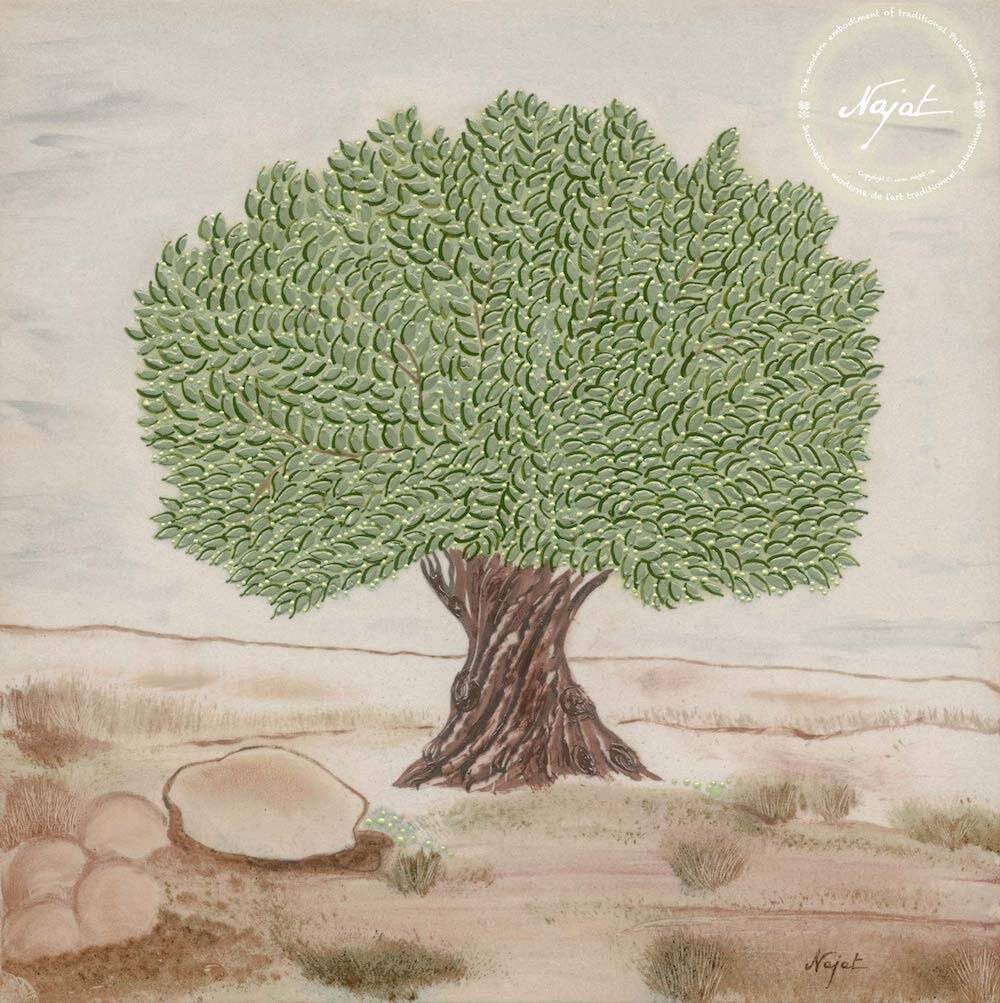
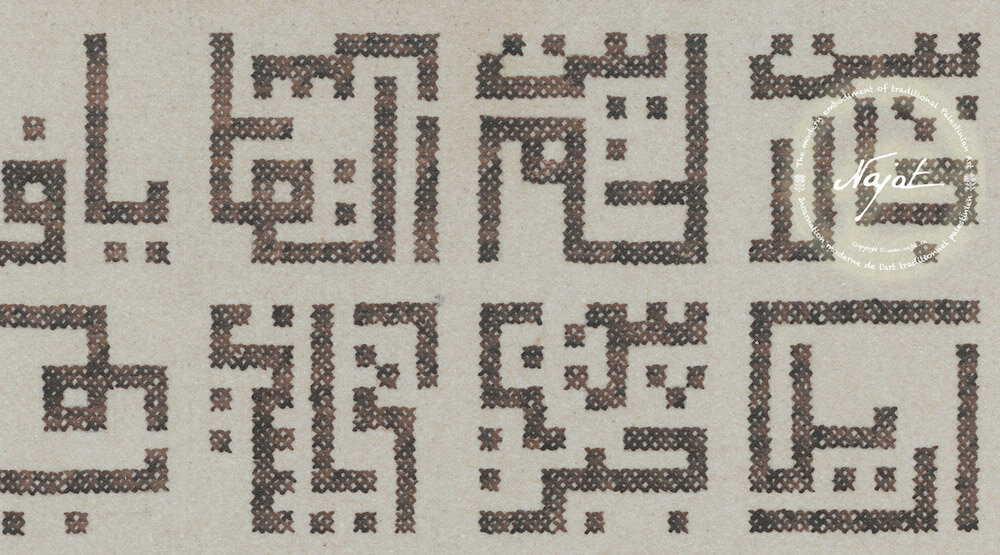
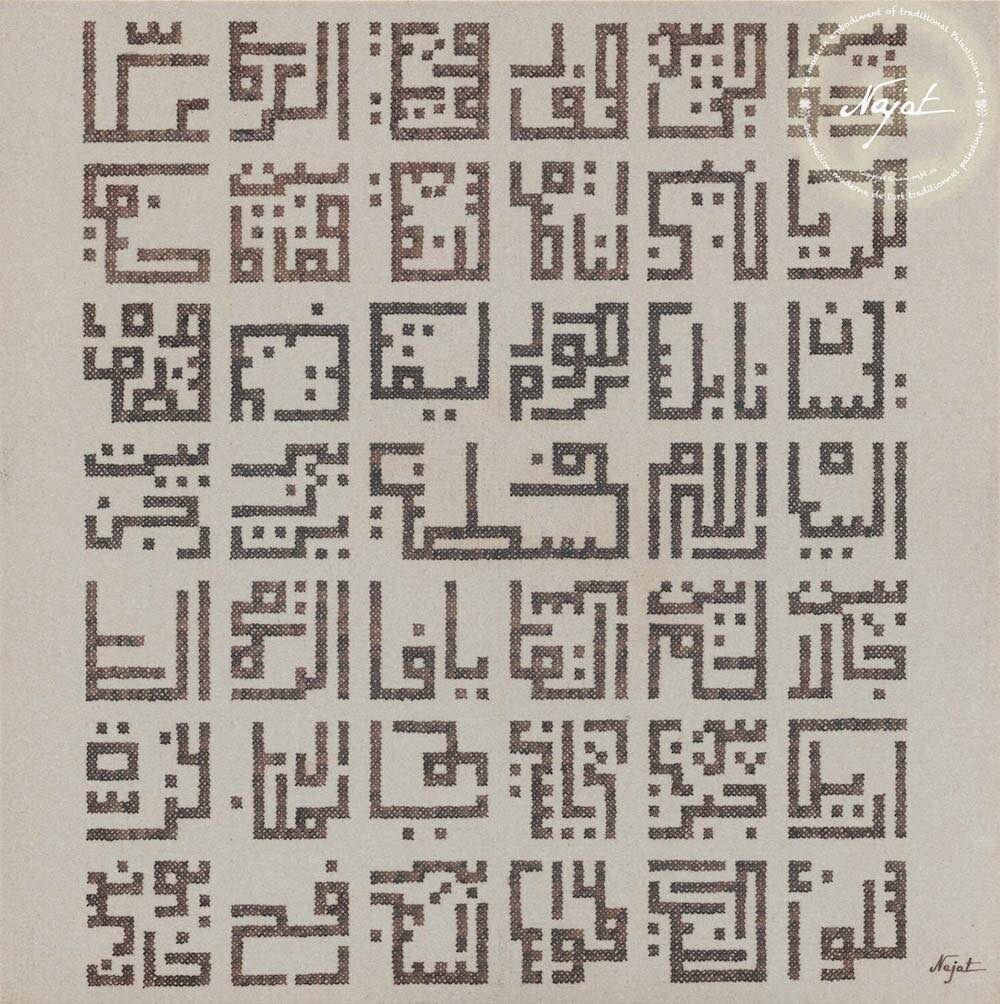
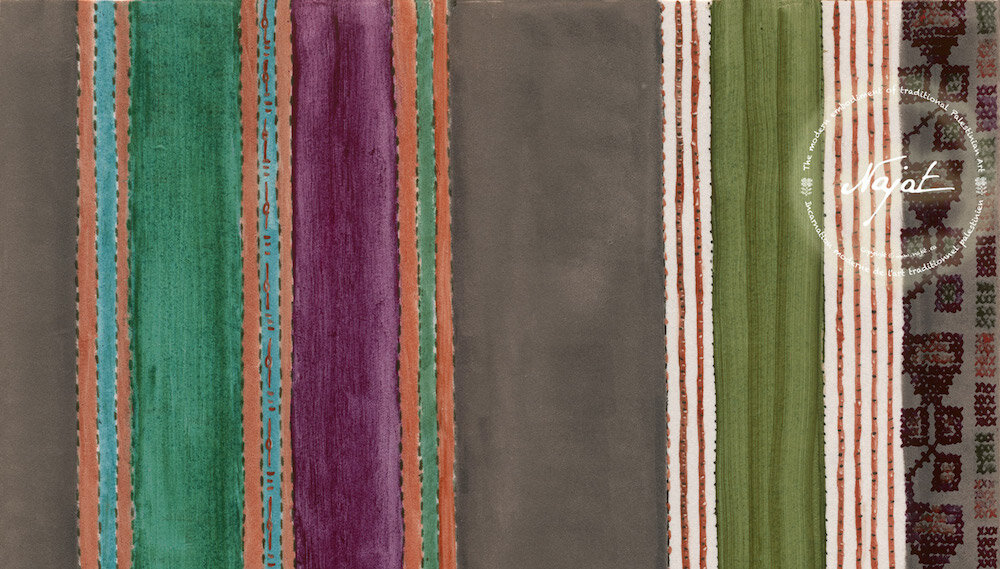

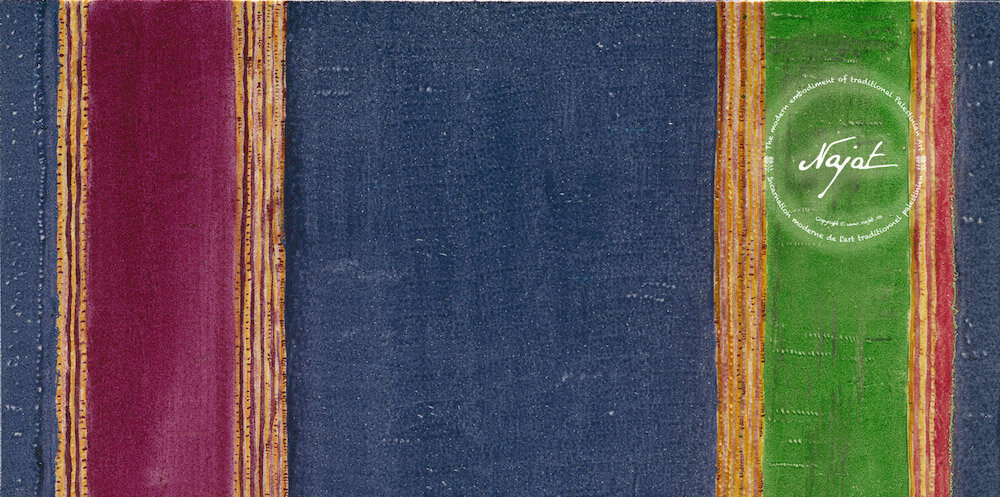















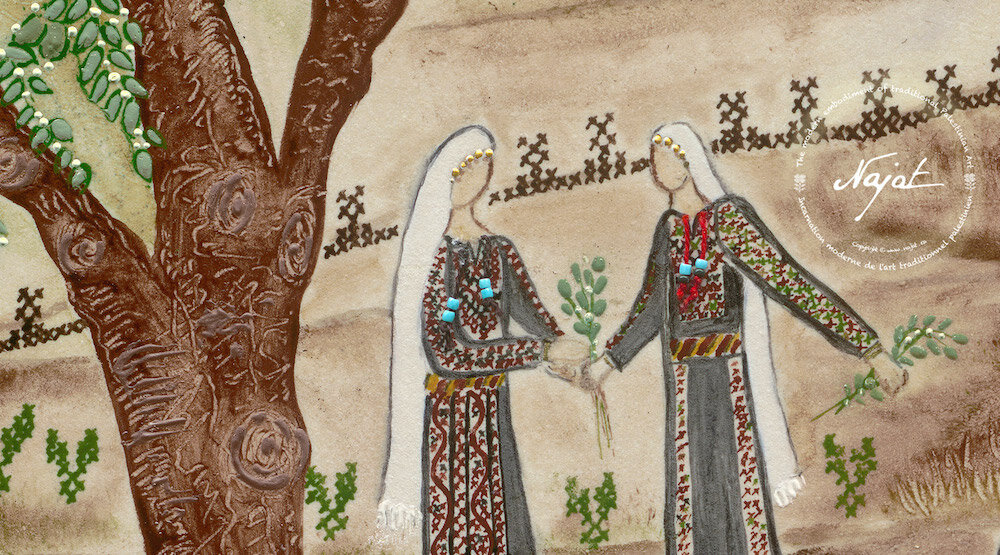
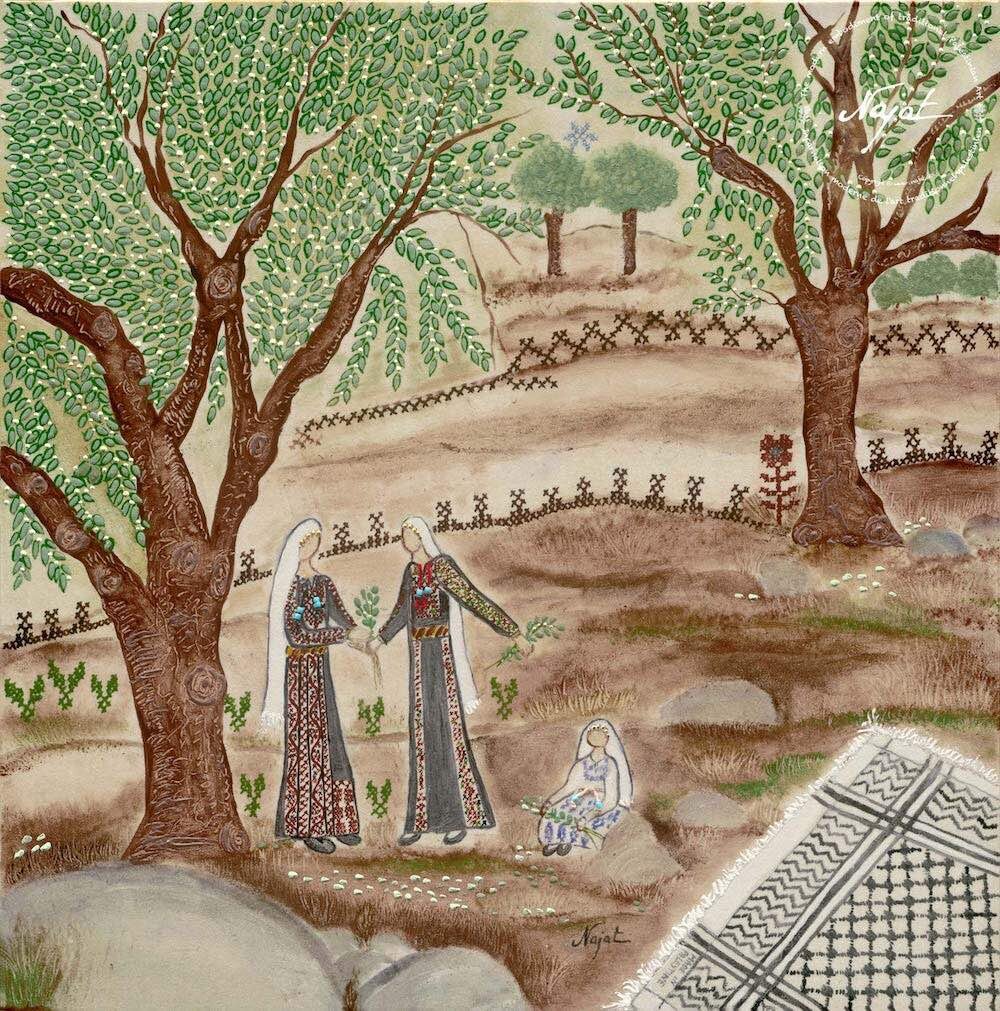
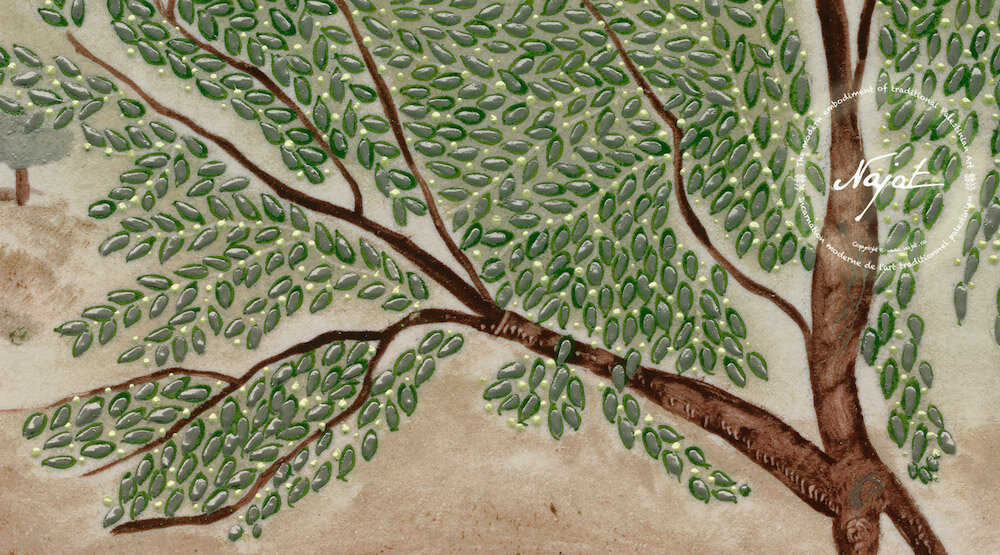

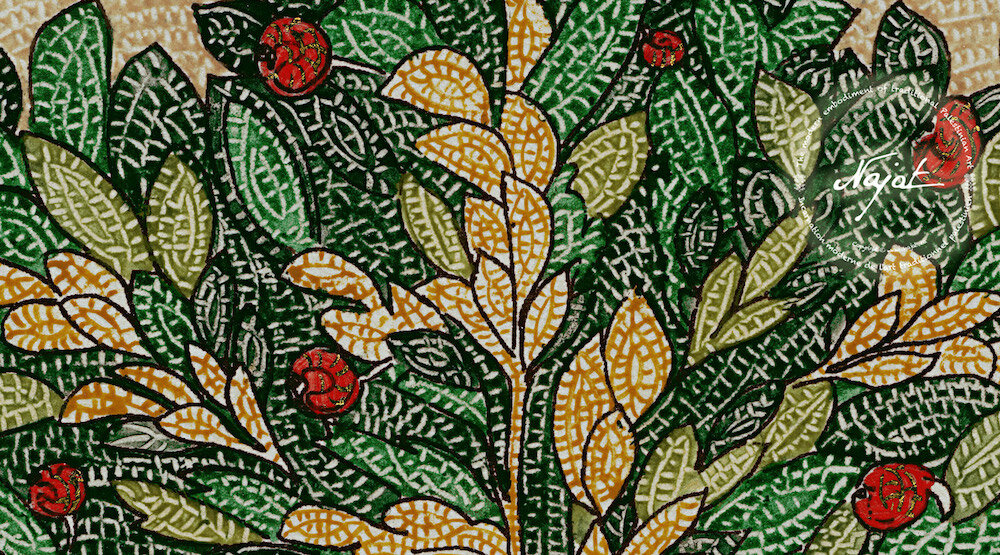

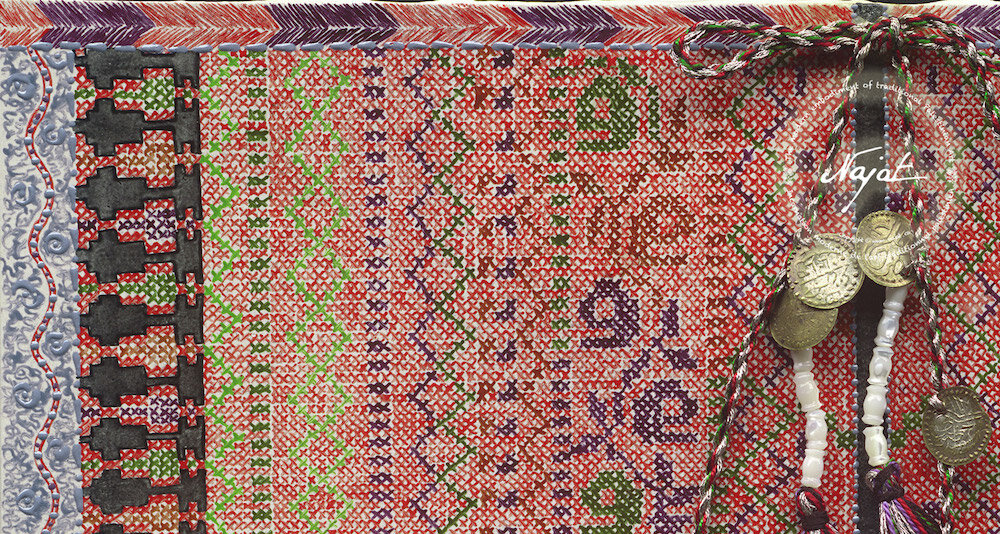
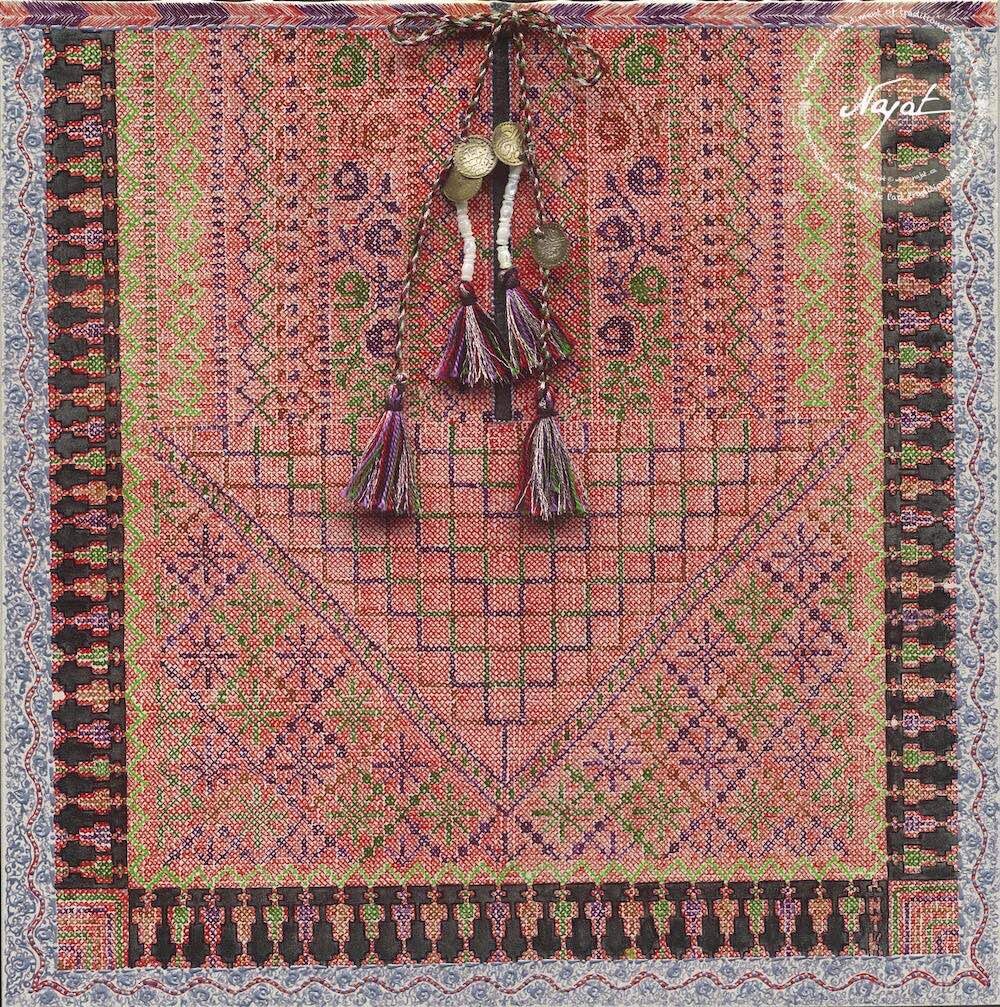

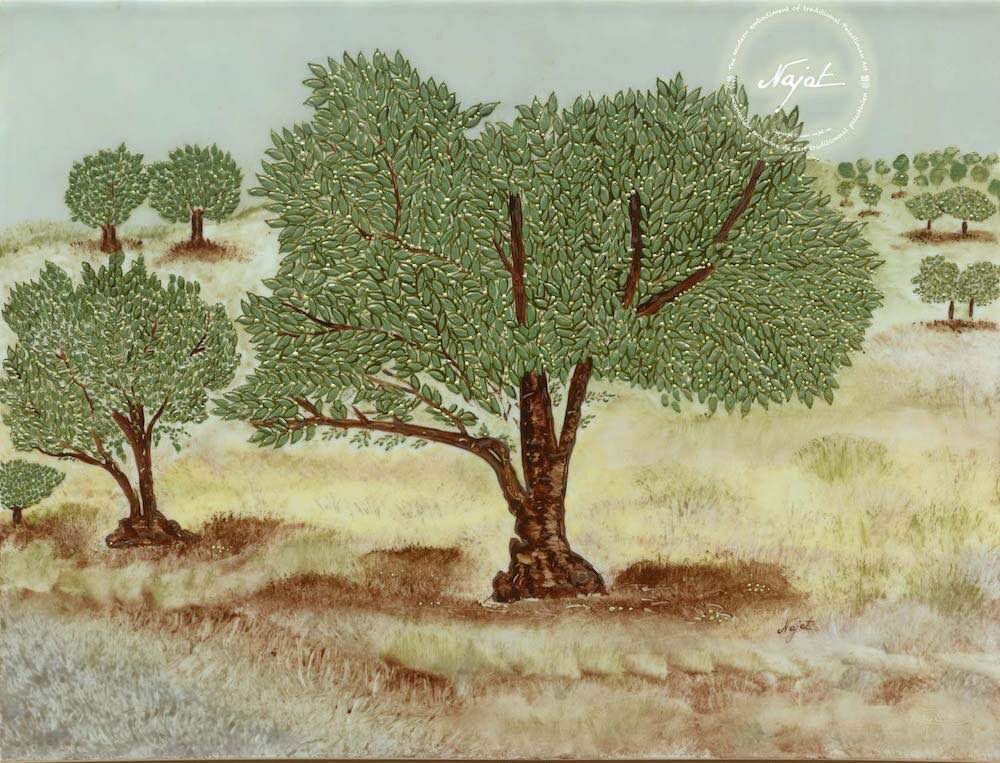

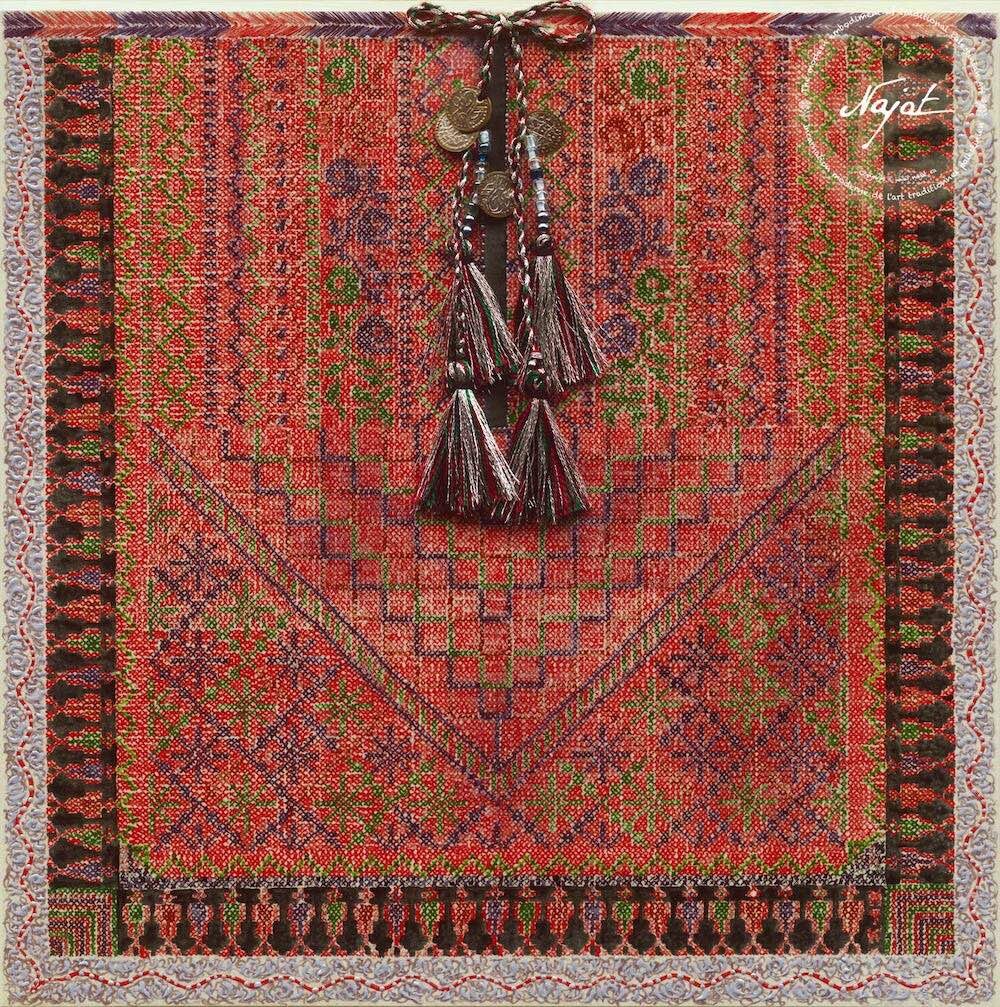

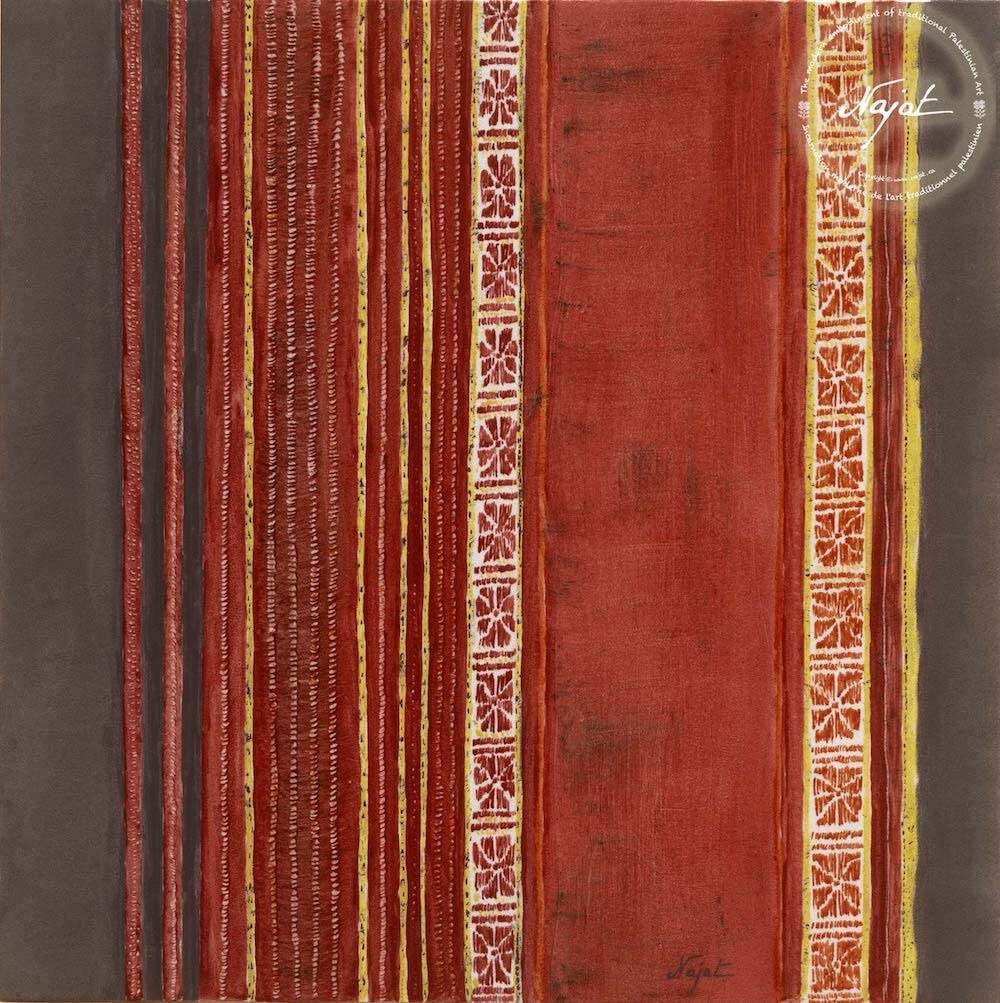







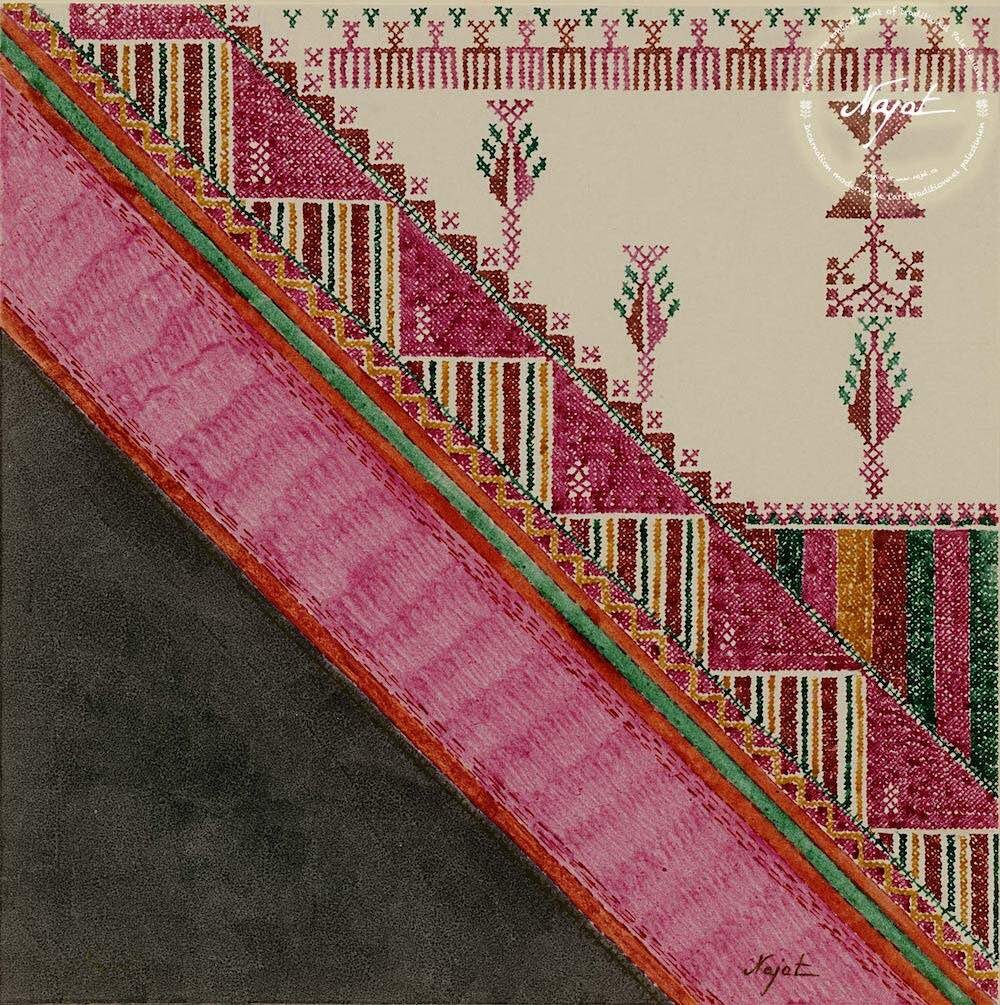











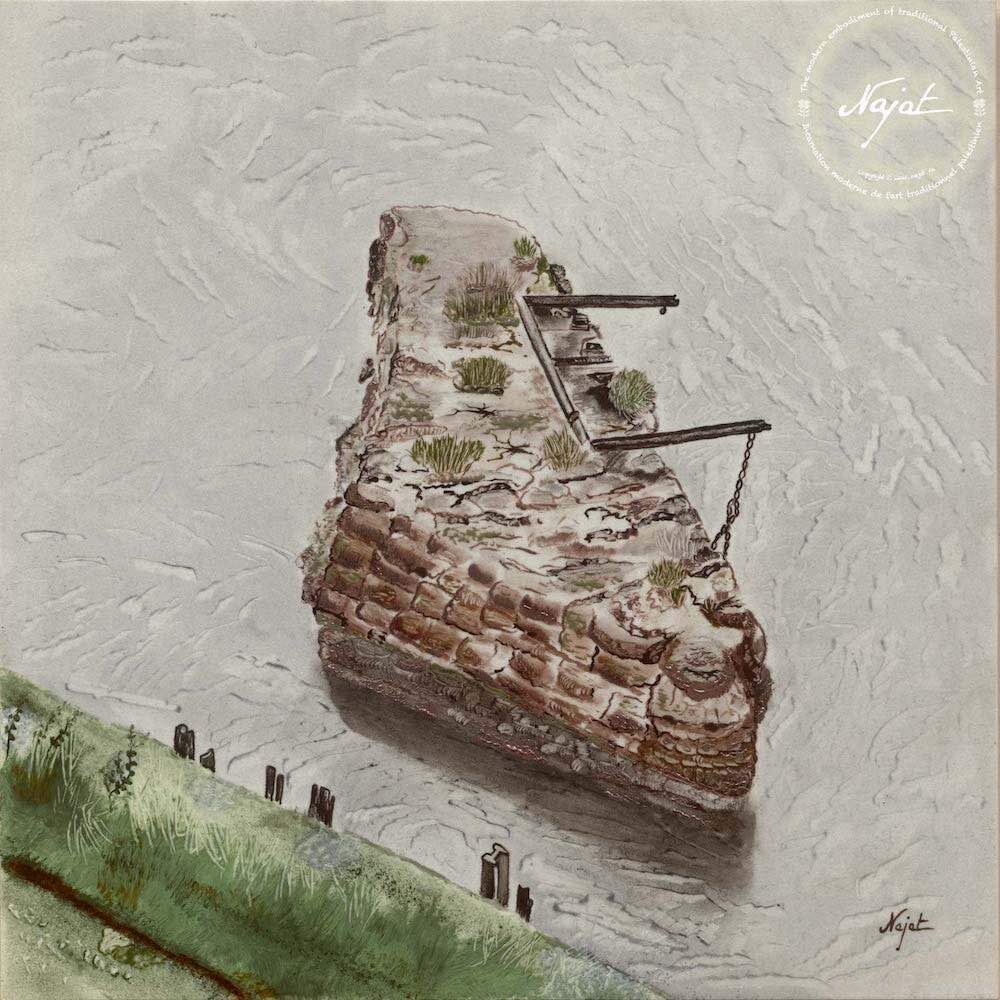














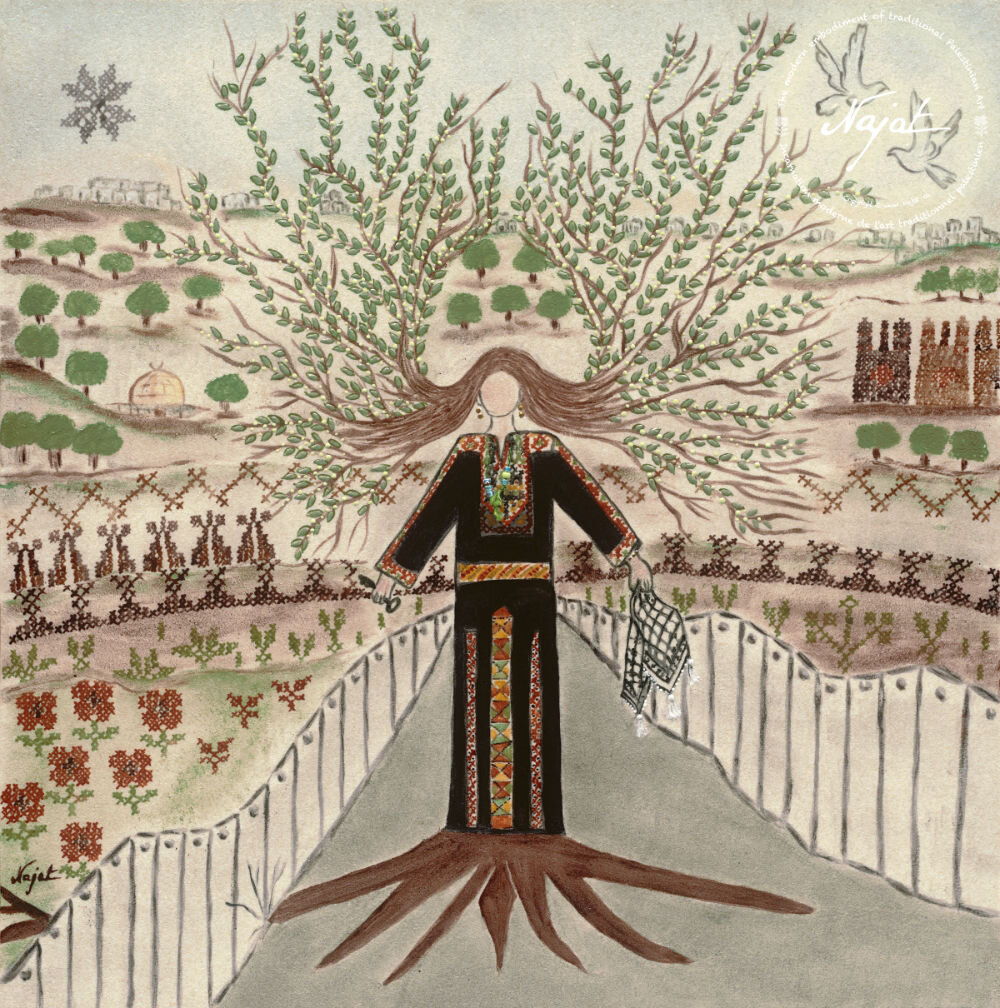



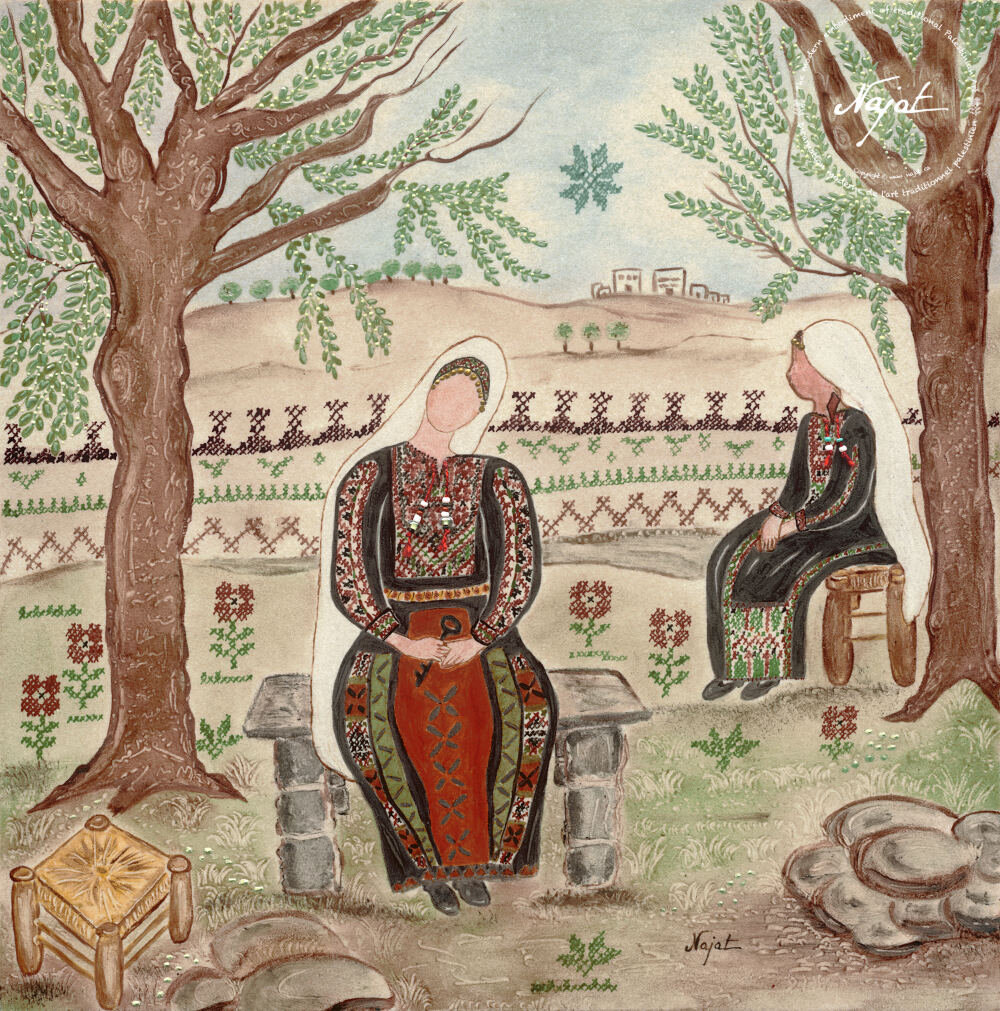



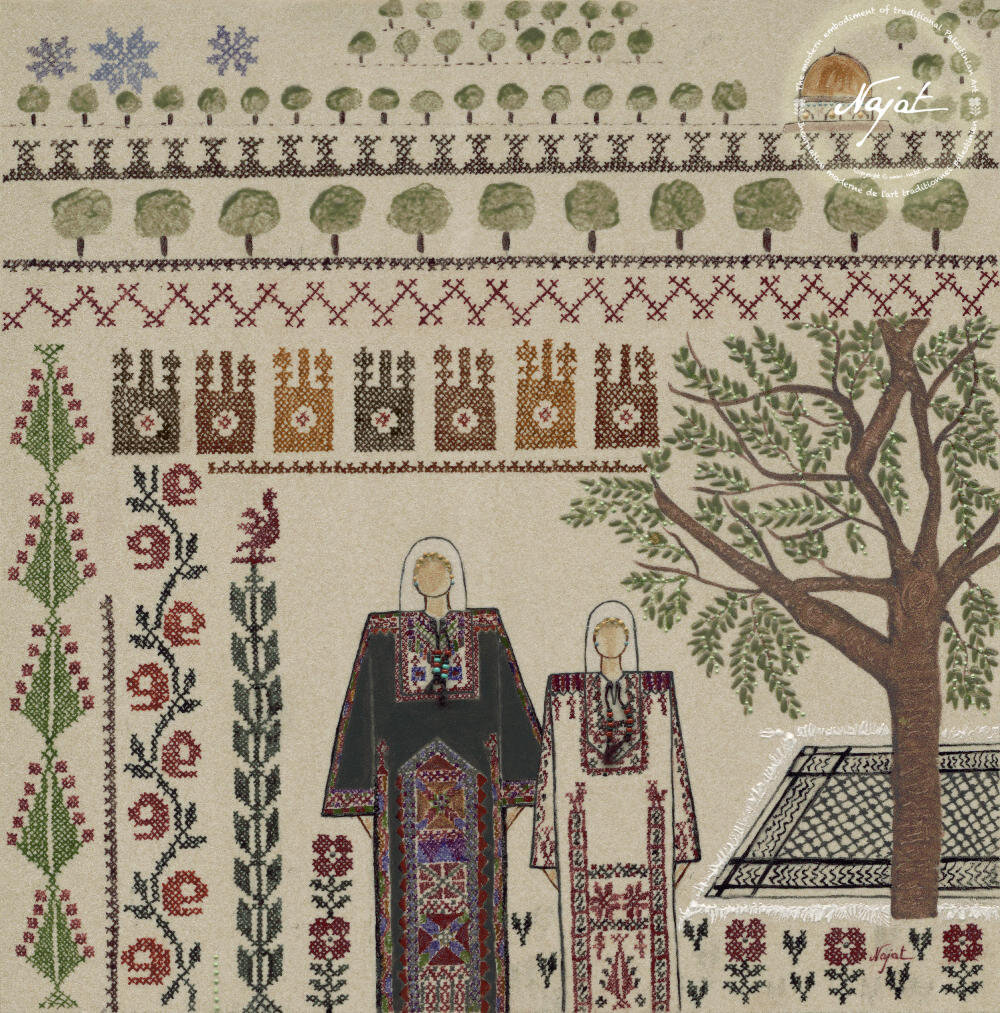

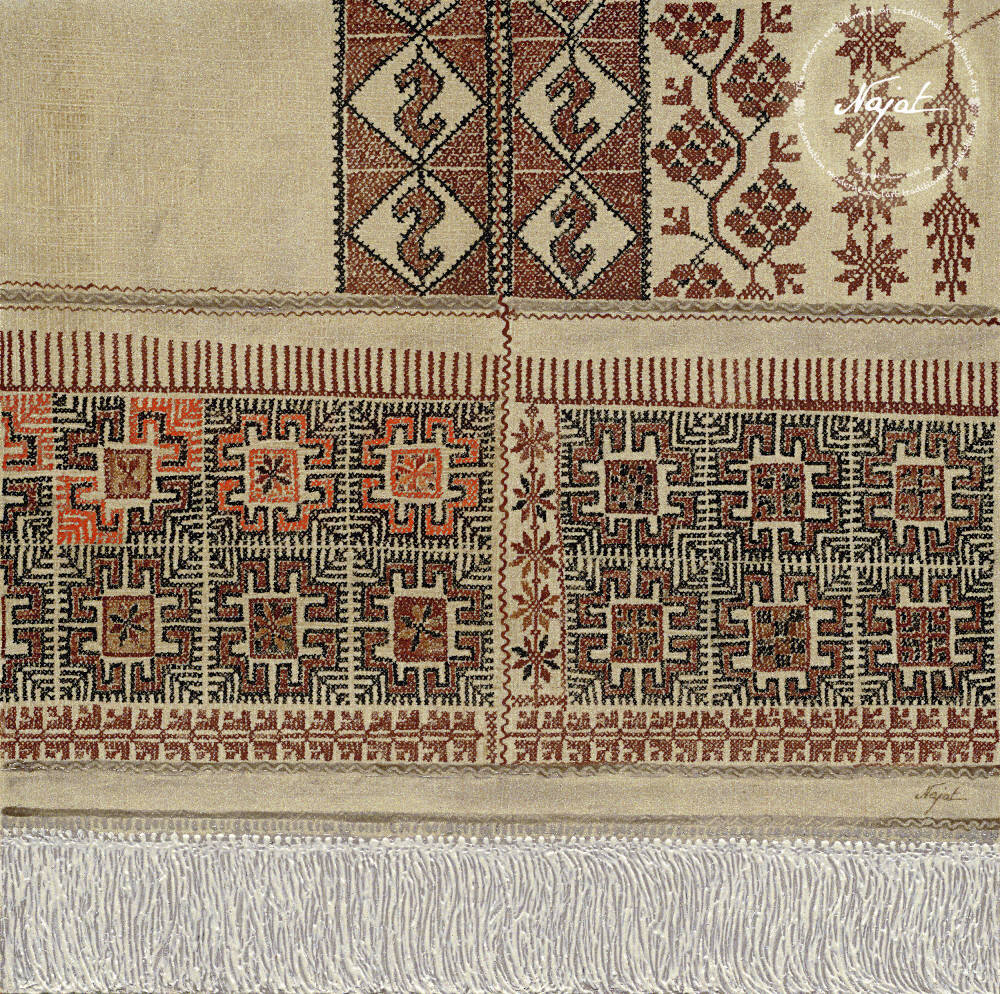
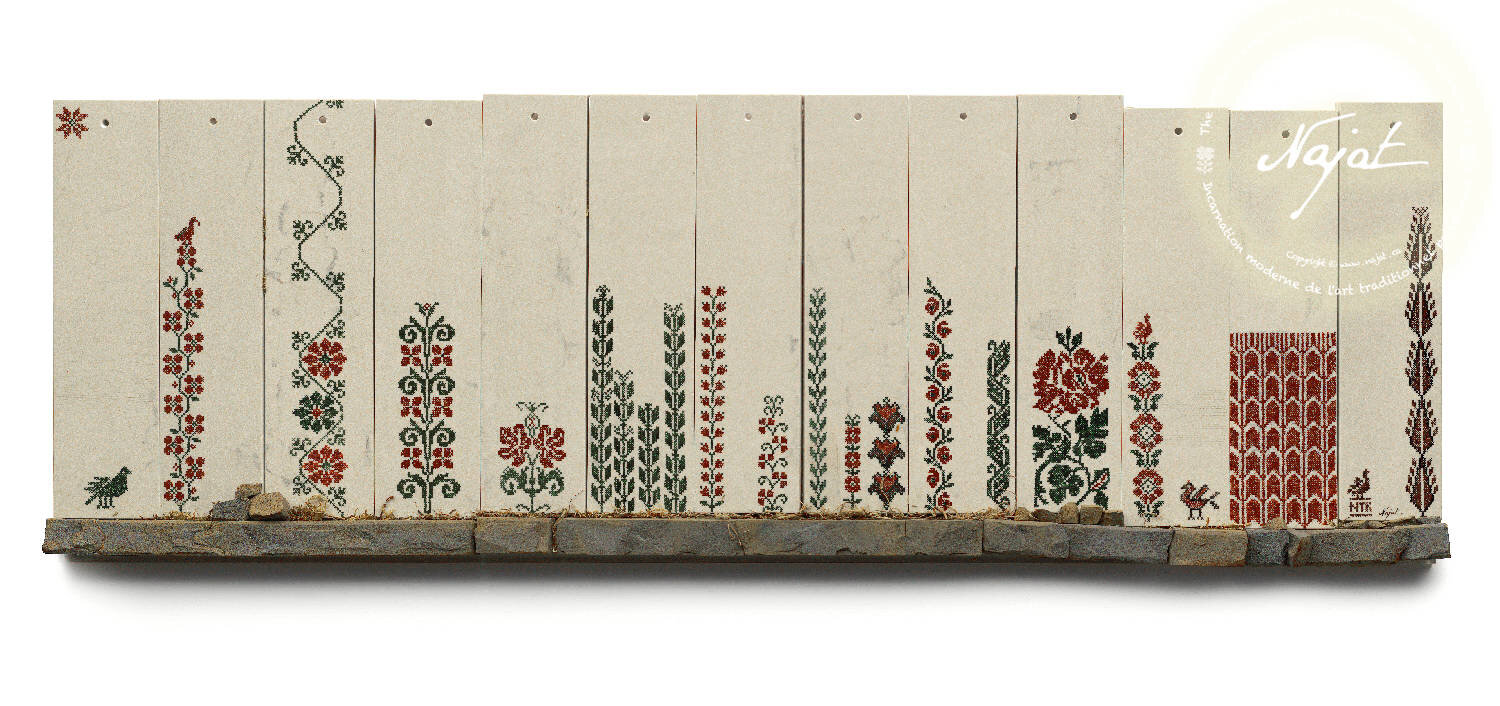
Ramallah embroidery has a distinct characteristic of its own. White linen fabric, called Roumi, was woven locally with a specific width and was embellished with red and black embroidery.
Some of the most famous motifs and patterns typical of this area are: The Leech which is Ollaiq in the form of a capital “S” is a symbol of good health and survival. The Tall Palms, the Zigzag motif, Cauliflower, Apples arch, Bachelors cushions, Bakers Wife, Carnation, Cypress Trees, Flower pots, Foreign Rainbow, Geese, Peacock Branch, Rooster, Snake and the Serpent, Stars to name some more.
Technique: Hand painted pen work on porcelain, presserving the cross stitch designs taken from Ramallah area on porcelain.
Available for purchase:
Ramallah embroidery has a distinct characteristic of its own. White linen fabric, called Roumi, was woven locally with a specific width and was embellished with red and black embroidery.
Some of the most famous motifs and patterns typical of this area are: The Leech which is Ollaiq in the form of a capital “S” is a symbol of good health and survival. The Tall Palms, the Zigzag motif, Cauliflower, Apples arch, Bachelors cushions, Bakers Wife, Carnation, Cypress Trees, Flower pots, Foreign Rainbow, Geese, Peacock Branch, Rooster, Snake and the Serpent, Stars to name some more.
Technique: Hand painted pen work on porcelain, presserving the cross stitch designs taken from Ramallah area on porcelain.
Available for purchase:
Ramallah Metal Chromaluxe Print
Ramallah Phone Case
Purchase the Canvas
V is for Victory. Inspired by the Hand of Fatima and the power of Khamsa, 5 Vs overlap one another in unison creating a sharp image based on Palestinian embroidery designs and colors from the Gaza region.
Hope Collection (piece of 1 of 5)
Technique: Hand painted pen work in cross stitch designs taken from Gaza area on porcelain.
Hand painted pen work on porcealin preserving the cross stitch designs from the Usduud region.
Purchase the Chawl of Usduud Canvas
Decorated with the orange blossoms, rose buds and Cypress trees from Gaza's Beit Dajan motifs, three Ls environ time represented by El Sa'a, The Hour or Watch, shaped like a Qubab or Dome symbolizing eternity, for Liberty is only a matter of time no matter how long it takes.
Hope Collection (piece of 2 of 5)
Technique: Hand painted pen work in cross stitch designs.
Two inverted Rs assert the Right of Return by depicting two resilient olive trees designed from the Ramallah area known as Irq Al-Zatoun, firmly rooting themselves into Sour Al-Quds or The Walls of Jerusalem, while the presence of two Doves pave the road of Peace.
Hope Collection (piece of 3 of 5)
Technique: Hand painted pen work on porcealin preserving the cross stitch designs from the Ramallah region.
By symmetrically balancing each other in perfect harmony, two Es reflect Equality. The designs of this moving piece emanate from the floors of Jerusalem's Noble Sanctuary, the Haram Al Sharif, and Gaza's famous Cushion motif, with roses and birds completing the center.
Hope Collection (piece of 4 of 5)
Hand painted pen work on porcelain preserving the cross stitch designs.
Scripted in elegant Vivaldi writing, and patterned with designs from Sur Al-Quds or The Wall of Jerusalem, a majestic P takes center stage reflecting Palestine's ultimate struggle for Peace, surrounded by two doves carrying their olive branches.
Hope Collection (piece of 5 of 5)
Hand painted pen work on porcealin preserving the cross stitch designs.
Purchase the canvas
Villages of Palestine. Inspired by Samia Halaby’s original design, several more Palestinian cities and villages were added in Kufi script and handed painted in cross-stitch. The Brown colour was chosen, representing the soil of Palestine
Purchase the Villages Canvas
Malek Abu Wardeh fabric, woven in Bethlehem
Purchase the Green Textile Canvas
Purchase the Blue Textile Canvas
Old Palestine engraved in the ancient olive tree which still bears fruits... Cross stitch depicting the Wall of Jerusalem, the flower of Ramleh and the star of Bethlehem
Technique: Hand painting using a brush and raised enamel to give each leaf a dignified luminous effect. Pen work is used for the cross stitch patterns.
Purchase the Sisters canvas
The spirits of the uprooted trees are rebelling. They nourish, give hope, beauty and light to the living one which stands majestically and refuses to be uprooted. Its roots anchored profoundly in the land of Palestine to secure its survival for future generations.
Other spirits rebel by finding their way in the landscape in the form of Palestinian cross-stitch motifs: the Palm Trees; Olive Leaves; Vine Fields; Mountains of Jerusalem and the Stars of Hebron and Bethlehem, all of which shed peace, harmony and serenity around.
Technique: Hand painting on porcelain using enamel for raised work on the olive leaves. Cross stitch in pen work, brush and special colours were used as well. Several firings at high temperature were required.
Near the town of Jericho, Palestine, are the ruins of an impressive country residence named after the Umayyad Caliph Hisham Ibn Abd al-Malik (724-743 AD). The house contained one of the most beautiful and elaborately decorated mosaic floors in the world, entitled the "Tree of Life” mosaic.
The design, represented by a fruit tree and gazelles, was designed to resemble an oriental carpet. In 746, the sumptuous palace was levelled by an earthquake, which had also destroyed the Church of the Holy Sepulchre in Jerusalem. The accumulated sand and debris helped preserve the palace's lovely mosaics.
The depiction of animals represent the Good and Evil in life. It is said that when the Tree of Life reaches its full height, it will emit a light that spreads around the world.
Najat's Artistic Technique:
Najat’s hand-painted porcelain captures the essence of this historic mosaic’s effects by applying a special painting technique of her own using both pen and brush to create a mosaic effect. The tile then undergoes several firings at high temperature in a special kiln.
Purchase the Tree of Life Canvas
It stands majestically with its roots entrenched in the Palestinian land bearing its olives, the Fruits of Peace.
The Mountains of Jerusalem, the Olives Leaves, the Old man's Teeth and the Flower of Ramla motifs make their presence in cross stitches, which for centuries have embellished the costumes of the village women of Palestine
Purchase the Rooted Tree Canvas
Mother, daughter and granddaughter under the olive trees picnicking
Technique: Hand painting using brush, pen and raised enamel work for the leaves of the olive tree.
Purchase the Three Generations Canvas
An olive grove with its trees bearing the fruits of peace, in harmony with the Palestinian cross stitch embroidery patterns that embellish the women’s village dresses, the flower of Ramla, and the star of Bethlehem are combined to stimulate a nostalgic feeling to our beloved land.
Technique: Hand painting using raised enamel to give each leaf a dignified luminous effect. Pen work is used for the cross stitch patterns. The Porcelain tile is then fired several times to preserve the work.
Purchase the Nostalgia Canvas
Near the town of Jericho, Palestine, are the ruins of an impressive country residence named after the Umayyad Caliph Hisham Ibn Abd al-Malik (724-743 AD). The house contained one of the most beautiful and elaborately decorated mosaic floors in the world, entitled the "Tree of Life” mosaic.
The design, represented by a fruit tree and gazelles, was designed to resemble an oriental carpet. In 746, the sumptuous palace was levelled by an earthquake, which had also destroyed the Church of the Holy Sepulchre in Jerusalem. The accumulated sand and debris helped preserve the palace's lovely mosaics.
The depiction of animals represent the Good and Evil in life. It is said that when the Tree of Life reaches its full height, it will emit a light that spreads around the world.
Najat's Artistic Technique:
Najat’s hand-painted porcelain captures the essence of this historic mosaic’s effects by applying a special painting technique of her own using both pen and brush to create a mosaic effect. The tile then undergoes several firings at high temperature in a special kiln.
Purchase the Tree of Life Canvas
Beit Dajan, an inland village, was well known to produce among the finest and most elaborate Palestinian embroidery. Orange groves were plentiful in Jaffa, Ramleh and Beit Dajan. The village women used to take the name of the motifs they embroider on their dresses from their surroundings, hence the name of the most important patterns that are typical of this area: "The Orange Blossom" which is sometimes called Rose buds "Irq El Nafnouf" in Arabic.
The stitches were perfectly embroidered close together using various shades of red, deep maroon and subsidiary colours such as fuchsia, orange, green and purple.
Silver cord couching embroidery was an influence of the Talhami stitch of Bethlehem. Learning embroidery in Beit Dajan was as essential as going to school. To execute their master pieces, the village women used to discuss their dresses when they visited each other, which in turn inspired beautiful and carefully chosen designs.
This chest panel illustrates cross stitch motifs by the name of the Cyprus Trees (Bald Trees), the Mountains, Earrings, Steps, Light House, Saw and Old Man's Teeth. Domes or Qubab & Waves (Mawj el Bahr) are produced using couching embroidery.
Najat's Artistic Technique: Pen work for cross stitch work, raised enamel for couching embroidery hand painted on porcelain.
Purchase the Beit Dajan Canvas
It is harvest time. This art piece represents the olives on the trees waiting to be picked.
Purchase the Olive Groves Canvas
Beit Dajan, an inland village, was well known to produce among the finest and most elaborate Palestinian embroidery. Orange groves were plentiful in Jaffa, Ramleh and Beit Dajan. The village women used to take the name of the motifs they embroider on their dresses from their surroundings, hence the name of the most important patterns that are typical of this area: "The Orange Blossom" which is sometimes called Rose buds "Irq El Nafnouf" in Arabic.
The stitches were perfectly embroidered close together using various shades of red, deep maroon and subsidiary colours such as fuchsia, orange, green and purple.
Silver cord couching embroidery was an influence of the Talhami stitch of Bethlehem. Learning embroidery in Beit Dajan was as essential as going to school. To execute their master pieces, the village women used to discuss their dresses when they visited each other, which in turn inspired beautiful and carefully chosen designs.
This chest panel illustrates cross stitch motifs by the name of the Cyprus Trees (Bald Trees), the Mountains, Earrings, Steps, Light House, Saw and Old Man's Teeth. Domes or Qubab & Waves (Mawj el Bahr) are produced using couching embroidery.
Najat's Artistic Technique: Pen work for cross stitch work, raised enamel for couching embroidery hand painted on porcelain.
Shop: Buy the Beit Dajan Canvas
Malek Abu Wardeh fabric, woven in Bethlehem
Purchase the Red Textile Canvas
The cross stitch sampler. In this fabulously decorative piece, patterns and symbols from all over Palestine can be found: From the Moon of Bethlehem and Cypress trees to the Tall Palm trees and Pasha’s Tent; From the Road to Egypt and Star of Hebron to the Water Springs and Old Man’s Teeth; the Al Kohol bottle, along with Ladders, traditional Feathers, Coffee Bean, Chest Panel Dividers, Flowers and Cauliflowers, also fulfill this piece.
Purchase the Sampler Canvas
Modernized Chest Panel, using fuchsia, green and orange colours that are typical of the striped fabric woven in Al Majdal. Central medallion is a Cypress pendant, with Flower Pot Branch on the sides from the Gaza region.
Back and side panel taken from Al Majdal region dress with its typical colours, and Cyprus trees, emulates and palm trees as the main motifs used.
Side Panel using the striped Al Majdal fabric with motifs from Gaza depicting both Eyes on one hand, and Cypress trees on the other.
Olive Grove with Fellaha presenting who we are: We are the Olive Trees, the Kuffieh, the embroidered dresses and the star of Bethlehem and the map of Palestine embodied in our olive trees.
Technique: Hand painting using brush, pen and raised enamel work for the leaves of the olive tree.
Purchase the Fallaha Canvas
The Eye in the centre is watching tirelessly over the fields. The Eye protects the apple groves, the olive trees, the pine trees and the palm trees. The Eye reaches the four corners, which are guarded by the doves of peace.
Shop: Buy the Fields of Palestine Canvas
Purchase the Canvas
Gaia represents this land that should emanate peace and love throughout the universe.
It is the beating heart of the world which is responsible for harmony, stability, balance and equilibrium to the whole planet.
Like a mother protecting, nurturing, providing and caring for her children, expecting them to transcend this love and grace throughout humankind...this mother land should adopt the same path.
This rock, to me, symbolises Palestine: The Holy land of the prophets.
The Male, represented by the Fellah or Farmer, ploughs the fields, plants the Cypress and Palm trees as well as Orange groves, as his eyes reach the horizons of his land to protect it from evil. Emulates are guarding and protecting the four corners of the earth. He is the Yang: a strong, solid, focused, masculine, Palestinian character.
Purchase the Yang canvas
The triangular shape symbolize femininity, birth and preservation of generations. It asserts its divine importance of the woman in Palestinian society, culture and history. She is the Yin, characterized by soft depictions of floral motifs and colours, their roots entrenched in her native land of Palestine.
Purchase the Yin canvas
Emanating from the Jaffa region these flowers pots hold roses.
Divided into four square compartments and tilted in diamond shape, this unique piece embodies several symbols from Bersheeeba, Ramallah, Hebron, Bethlehem and Gaza, such as Cypress trees, the Eye of the Cow, a star disc, a Lupine Branch, and the Moon.
Today and tomorrow are continuations of yesterday. One has to refer to the past in order to establish oneself in the future. The rebirth hence contributes in preserving the past, and the past inspires the future.
Today and tomorrow are continuations of yesterday. One has to refer to the past in order to establish oneself in the future. The rebirth hence contributes in preserving the past, and the past inspires the future.
This motivates her determination to further strengthen her deep roots in her beloved land. Her will power transforms her into a strong, dignified olive tree that defines her identity and her inalienable right to be in her home, in her land. This metamorphosis is born out of her struggle, resilience and resistance-- all characteristics acquired from the olive tree, which is a symbol of peace.
~ Catharsis ~ Catharsis is every artist's seeking throughout the creative process. It is an internal journey through time that paves a path towards purification and liberation from suppression, nestled deep within them.
Through wrath and resentment to dispossession and desperation, a sense of freedom is achieved when the artist executes the final brush stroke.
The aspiration for liberation, dignity and peace on one’s land are the dynamic forces that motivate the Palestinian Fellaha, or village woman, who ponders about her destiny under the olive tree, as the dove gently rests on the olive branch.
At last, she is liberated, pure and free, dignified and strong, to live her long awaited right of return and belonging.
~ Catharsis ~
Catharsis is every artist's seeking throughout the creative process. It is an internal journey through time that paves a path towards purification and liberation from suppression, nestled deep within them. Through wrath and resentment to dispossession and desperation, a sense of freedom is achieved when the artist executes the final brush stroke.
With hope we shall return to our land to fulfill our most innate dreams
A mother sitting on the stone bench unfolding her people’s memories and stories, is ready to hand down to her young daughter the key she held on for decades. The key to her home in Palestine she longs deeply for, reassuring the young generation to never lose hope for the right to return.
~ Fordibben Colours ~
"A 1980 law forbidding artwork of "political significance" banned art composed of the four colours of the Palestinian flag, red, green, white and black. Palestinians were arrested for displaying such artwork. The ban was lifted after the signing of the Oslo Accords in 1993. Palestinian artists would not be allowed to paint a flower field using those colours. Even avoiding the "direct and noticeable" use of the colours, an artist would nevertheless be committing felony. The police would storm the art gallery in the West Bank at the time and storm artists houses and confiscate them." Notes about the artwork: They are a series of 3 artworks representing The forbidden colors are rendering freely these sceneries of the peaceful olive grove. They depict the village women, wearing their beautiful hand embroidered Palestinian costumes, picking the fruits of peace during the festive olive harvest season. Cross stitch motifs, taken from Palestinian patterns and designs, paint the fields and dunes surrounding them, asserting the identity of the land. Motifs like: “The Walls of Jerusalem”, “the Road to Nablus”, “the Old Man’s teeth” and “The Star of Bethlehem” The map of Palestine always hidden in the olive branches asserts its presence on this land.
A 1980 law forbidding artwork of "political significance" banned art composed of the four colours of the Palestinian flag, red, green, white and black. Palestinians were arrested for displaying such artwork. The ban was lifted after the signing of the Oslo Accords in 1993.
Palestinian artists would not be allowed to paint a flower field using those colours. Even avoiding the "direct and noticeable" use of the colours, an artist would nevertheless be committing felony. The police would storm the art gallery in the West Bank at the time and storm artists houses and confiscate them."
The forbidden colors are rendering freely these sceneries of the peaceful olive grove. They depict the village women, wearing their beautiful hand embroidered Palestinian costumes, picking the fruits of peace during the festive olive harvest season. Cross stitch motifs, taken from Palestinian patterns and designs, paint the fields and dunes surrounding them, asserting the identity of the land. Motifs like: “The Walls of Jerusalem”, “the Road to Nablus”, “the Old Man’s teeth” and “The Star of Bethlehem” The map of Palestine always hidden in the olive branches asserts its presence on this land.
Forbidden colours
"A 1980 law forbidding artwork of "political significance" banned art composed of the four colours of the Palestinian flag, red, green, white and black. Palestinians were arrested for displaying such artwork. The ban was lifted after the signing of the Oslo Accords in 1993.
Palestinian artists would not be allowed to paint a flower field using those colours. Even avoiding the "direct and noticeable" use of the colours, an artist would nevertheless be committing felony. The police would storm the art gallery in the West Bank at the time and storm artists houses and confiscate them."
The forbidden colors are rendering freely these sceneries of the peaceful olive grove. They depict the village women, wearing their beautiful hand embroidered Palestinian costumes, picking the fruits of peace during the festive olive harvest season. Cross stitch motifs, taken from Palestinian patterns and designs, paint the fields and dunes surrounding them, asserting the identity of the land. Motifs like: “The Walls of Jerusalem”, “the Road to Nablus”, “the Old Man’s teeth” and “The Star of Bethlehem” The map of Palestine always hidden in the olive branches asserts its presence on this land.
Cheerful and festive olive picking in Palestine depicts a joyful season.
Our Palestinian existence reminds us of cultural heritage, which stands majestically alongside our ancient olive trees.
A chest panel inspired from sit Widad”s book Threads of Identity. It is a typical example from Jerusalem area villages such as Lifta and Deir Yassine Using patterns like Tiles of Bethlehem Balat Bethlehem, Birds or Hamam motifs, Urf el Deeq rooster’s comb and crown patterns. This art piece is among the ones in the house today
This shawl from Hebron is also shown here today. The name in Arabic is Ghudfeh according to the same book mentioned earlier. It says “it is linen with silk cross stitch, and by tradition, the bride does the embroidery while the fringe is provided by the bridegroom”
Presented at the West Wing exhibition in the United Nations HQ in New York in 2012 as part fo the International Day of Solidarity with the Palestinian People, the day the United Nations provided Palestine with a non member observer status.
Also presented in the UN in 2007 (Rebelled Spirits)